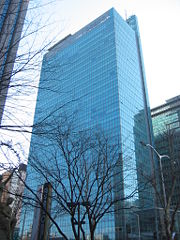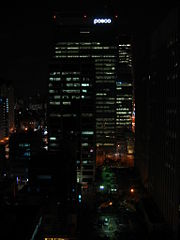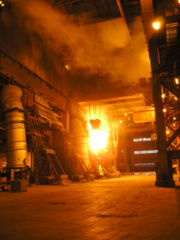POSCO
From Wikipedia, the free encyclopedia
| POSCO | |
|---|---|
| Type | Public (NYSE: PKX, LSE: PIDD, TYO: 5412) |
| Founded | 1968 |
| Headquarters | Pohang, Republic of Korea |
| Key people | Park Tae-Joon, Founder and Honorary Chairman Lee Ku-Taek, Chief Executive Officer Lee Dong-Hee, Chief Financial Officer Yoon Seok-Man, Chief Marketing Officer Chung Joon-Yang, Chief Operating Officer Lee Youn, General Superintendent of Stainless Steel Division Cho Soung Sik POSCO-India President |
| Industry | Steel |
| Products | Hot Rolled Steel, Steel Plate, Wire Rod, Cold Rolled Steel, Electrical Steel, Stainless Steel |
| Revenue | ▲ $27.48 billion USD Year to 31 Dec 2005 |
| Operating income | ▲ 6.07 trillion Korean Won (2005) |
| Net income | ▲ 4.10 trillion Korean Won (2005) |
| Employees | 28,853 (2005) |
| Website | http://www.posco.com |
The Pohang Iron and Steel Company, or POSCO (KRXS: 005490) (NYSE: PKX) (TYO: 5412) (LSE: PIDD), based in Pohang, South Korea, is the third largest steel producer in the world.
Currently, POSCO operates two steel mills in the country, one in Pohang and the other in Gwangyang. In addition, POSCO operates a joint venture with U.S. Steel, USS-POSCO, which is located in Pittsburg, California.
Along with Samsung Electronics, POSCO is viewed by many Koreans as a symbol of national pride and 'can do' spirit. With the strong Korean shipbuilding and automobile industry dependent on POSCO for steel, it has been seen as the bedrock of Korea's industrial development over the past 40 years.
|
[edit] History
[edit] 1968–1971
In the 1950s, South Korean President Park Chung-hee's administration concluded that self-sufficiency in steel and the construction of an integrated steelworks were essential to economic development. Since South Korea had not possessed a modern steel plant prior to 1968, many foreign and domestic businesses were skeptical of Seoul's decision to invest so heavily in developing its own industry. Despite the skepticism, under founder Park Tae-Joon's lead, POSCO began production in 1972 just four years after the company's inauguration in April 1968 with thirty-nine employees.
Japan provided the money for the construction of the initial plant, following an agreement made at the Third South Korea-Japan Ministerial Meeting in 1969. Financing included US$73.7 million in government grants and loans, US$50 million in credit from the Japan Export-Import Bank, and technical assistance from Nippon Steel and other corporations. This cooperation was one consequence of the normalization of relations with Japan in 1965 and reflected the view of the government of Japan as noted in the Nixon-Sato communique of November 21, 1969, that "the national security of the Republic of Korea is essential to the security of Japan."
[edit] 1972–1992
POSCO first began to sell plate products in 1972 and focused its sales policies on the domestic market to improve steel self-sufficiency at home. It made special efforts to supply quality iron and steel to related domestic companies at below export price to strengthen their international competitiveness.
POSCO produced 6.2 million tons of raw steel in 1980, recording a 13% increase over the previous year, and was one of the few exceptions when almost all areas of the Korean economy were in economic depression. Domestic industries absorbed POSCO's major products such as automobile and home appliance manufacturers consuming hot rolled products, shipbuilding and construction and engineering companies consuming medium plates, and electric motor and transformer manufacturers consuming electrical sheets. Some over-produced products were exported to foreign countries but the significant import of sections for construction left Korea as a net importer. Globally, POSCO was already the most efficient steel producer in certain products.
By the late 1980s POSCO's growth had been immense. It was the fifth biggest steel company in the world, with an annual production approaching 12 million tons worth 3 trillion won. POSCO's continued to expand productivity and size at a time when the steel industries of the United States and Japan were declining. POSCO completed its second-phase mill at Gwangyang in August of 1988. A third-phase mill completed in 1992 further increased crude steel production to a total output of approximately 17.2 million tons a year. In terms of productivity, POSCO was the world's best steel manufacturer throughout the late 1980s and also was at the top in terms of facilities.
Pohang, previously a fishing port whose major industry was processing fish and marine products, became a major industrial center with almost 520,000 people. In addition to the huge integrated steel mill, Pohang became an industrial complex housing companies that manufacture finished steel products of raw materials provided.
[edit] 1992–1997
Changes in managerial systems and organizational structure accelerated in 1993 when POSCO's president and founder, Park Tae-Joon, who had wielded absolute managerial authority for more than 25 years, resigned.
These changes were not without controversy however. Park Tae-Joon was ousted under the Kim Young-sam government for alleged slush fund building and money laundering, which was later proven to be false, and went into "voluntary exile" in Japan. Most of the top management under him at the time were also fired. After the inauguration of the Kim Dae-Jung government and Park's rehabilitation and climb to power, most of these former managers were returned to their previous posts at the state owned steel maker. Then POSCO chairman Ryu Sang-bu and president Lee Ku-taek, and POSCO Development chairman Park Doo-pyo and managing director Cho Yong-kyong, all received support from Park who later went on to become the Prime Minister of Korea.
With the change in leadership -- from Park Tae-Joon to Ryu-Sang Bu, POSCO increased decentralization and diversification. POSCO's management emphasized greater flexibility, autonomy, and consensual decision-making processes. The chairman also moved to devolve more autonomy to the profit centres and changing from a strictly hierarchical organizational structure to one based on teams.
In July 1994, POSCO created two subsidiary companies, POSTEEL and POSTRADE. POSTEEL is the domestic sales and service arm of the company, while POSTRADE handles international trading of POSCO products. Both subsidiaries commenced full operation in September 1994, with all international POSCO affiliates transferred to POSTRADE by the end of that year. The landmark Posteel Tower on Tehran Street, in Seoul's Gangnam district (not to be confused with the POSCO Center, also on Tehran Street) was completed in 2003.
[edit] 1997–2000
In 1997, Seoul announced that it was going to transform POSCO into a private company in line with the government's new policy of privatizing government-owned corporations. The government planned to retain a majority share of the stock; initial reports in the South Korean press in 1998 indicated that the sale of public shares was going slower than anticipated. However, the administration led by Kim Young Sam changed the initial policy direction of privatization of POSCO and decided not to sell government-owned stock to keep it as a government investment enterprise.
But, the Kim Dae Jung administration following the Kim Young Sam administration listed privatization of public enterprise as a high priority policy in economic policy agenda to implement mainly because of outbreak of the economic crisis. The new administration decided to privatize POSCO and by 1998, the South Korean government had reduced its ownership of shares in POSCO to less than 20%, and more than 50% of the shares in POSCO were in the hands of foreign investors. In 2000, full privatization of POSCO was completed.
[edit] 2001–2006
As part of the privatization process, new Chairman Lee Ku-Taek began efforts to introduce a professional management and governance system of global standards for POSCO. Under the new governance system, management made accountability to shareholders a priority. POSCO also introduced a new performance-based evaluation and compensation system. Throughout most of its privatization drive, POSCO increased its revenue and business profit. Thanks to robust demand at home and in China, POSCO recorded the largest profits in the global steel industry in 2004. Net earnings from POSCO's array of steel products - used in everything from screws to skyscrapers - shot up 80% to $1.66 billion in 2004 from the previous year.
With increasing global competition, POSCO looked to China and India for new opportunities. South Korean wages were too high to support a whole range of activities and POSCO looked elsewhere for new projects while keeping the areas where they have a comparative advantage in South Korea. By 2006, POSCO had 26 subsidiaries and invested over $2.4 billion in fresh investment on mainland China, especially in galvanized and stainless steel to supply global auto and appliance makers that have opened plants there. In 2006, POSCO started operating the Zhangjiagang Pohang Stainless Steel(ZPSS) steel mill capable of producing 600,000 tons of stainless steel and hot-rolled products annually in China’s Jiangsu Province. As a result, POSCO became the first foreign firm operating an integrated stainless steel mill in China, handling the entire production process from smelting iron ore to finished products, including the cold rolled stainless plant it already operates.
In June of 2005, POSCO signed a memorandum of understanding with the State of Orissa in India. Under the agreement, POSCO plans to invest US$12 billion to construct a plant with four blast furnaces, an electricity plant, housing, and an annual production capacity of 12 million tons of steel, which is slated to start production in 2010. The project, which would start with a 3 million tonne capacity initially, would fetch revenue for the government to the tune of Rs 700 crore to Rs 800 crore (Rs 7-8 billion) annually. It would also provide direct employment to 13,000 people and ensure indirect employment for another 35,000. The Orissa State government also promised to provide a total of 600 million tons of iron sources, and will allow POSCO to use iron ore from these sources over the next 30 years. If the project goes ahead, it will be the single largest foreign direct investment in India as well as being the world's biggest greenfield steel plant ever.
Despite that the people of the proposed site for the factory have protested against the acquisition of their lands. Unable to break the resistance armed goons with the aid of pro-POSCO police and district adminstration attacked the villagers protesting peacefully. Crude bombs were hurled at an assembly of elderly women of the village. Several activists have bean brutaly beaten up by police and goons.
POSCO have pursued investment opportunities in other developing countries such as Vietnam and Mexico. It was announced in August of 2006 that POSCO will build a large-scale steel mill in southern Vietnam. POSCO plans to build the US$1 billion plant in two phases for hot-rolled and cold-rolled products by 2012. When completed, the mill is expected to produce three-million tons of steel products annually. Posco also plans to build a $250 million plant in the city of Altamira, Mexico, to produce 400,000 tons of galvanized steel sheet a year for automakers . The venture will be Posco's first wholly owned steel-plate plant in North America. Posco plans to begin construction in early 2008, and start operations in 2009, producing galvanized and galvannealed steel.
On June 30 of 2006, POSCO completed the construction of its sixth continuous galvanizing line (CGL) at its Gwangyang mill in the South Jeolla Province. With this new addition, POSCO becomes the no. 2 producer of sheet-steel just behind ArcelorMittal.[1]
[edit] Management organization

[edit] Head Office
POSCO's Headquarters, along with the POSCO Center, form the 'brain' of the company, overseeing major tasks, such as the management, planning, and finances of the steelworks at Pohang and Gwangyang. The construction of POSCO headquarters at 1 Goedong-dong, Nam-gu, Pohang, was completed on April 1, 1987, and has since become a structure that symbolizes the entire company.
[edit] POSCO Center
Winner of the 1995 Seoul Architectural Award for its progressive combination of modern design and eco-friendly engineering, POSCO Center is regarded as Korea's first state-of-the-art intelligent building. This landmark in the heart of southern Seoul's Teheran Valley high-tech venture corridor also hosts a wide variety of free cultural programs, events, and exhibitions throughout the year.
[edit] Pohang and Gwangyang Steelworks
Pohang - Constructed in four phases between April 1970 and February 1981 along Korea's southeast coast, the nation's first integrated steelworks has produced 230 million tons of pig iron through March 2004 - enough to build some 250 million compact cars. Crude Steel Production (2004) = 12.67 million tons
Gwangyang - Constructed in four phases between September 1982 and October 1992 on land Korea's southern coast, the nation's second integrated steelworks is among the world's most advanced. Gwangyang focus on manufacturing automotive steel, high-strength structure steel, API line pipe steel, and other strategic product categories. Crude Steel Production (2004) = 16.23 million tons
[edit] Subsidiaries
- POSCON
- POSBRO - A WiMAX/WiBro Mobile Internet terminal manufacturer.
- POSDATA - An IT solutions provider
- POSCO Engineering & Construction
[edit] Competitors
[edit] See also
[edit] References
- ^ Korea.net



